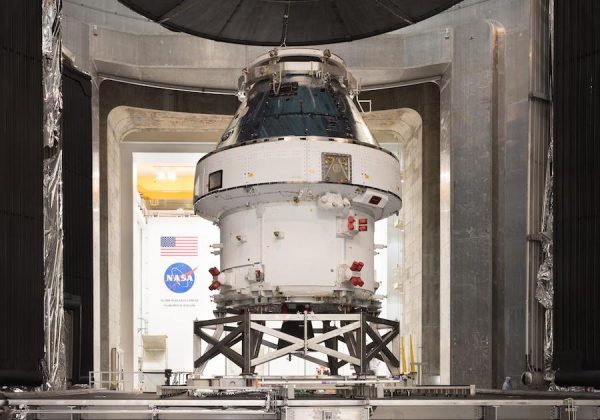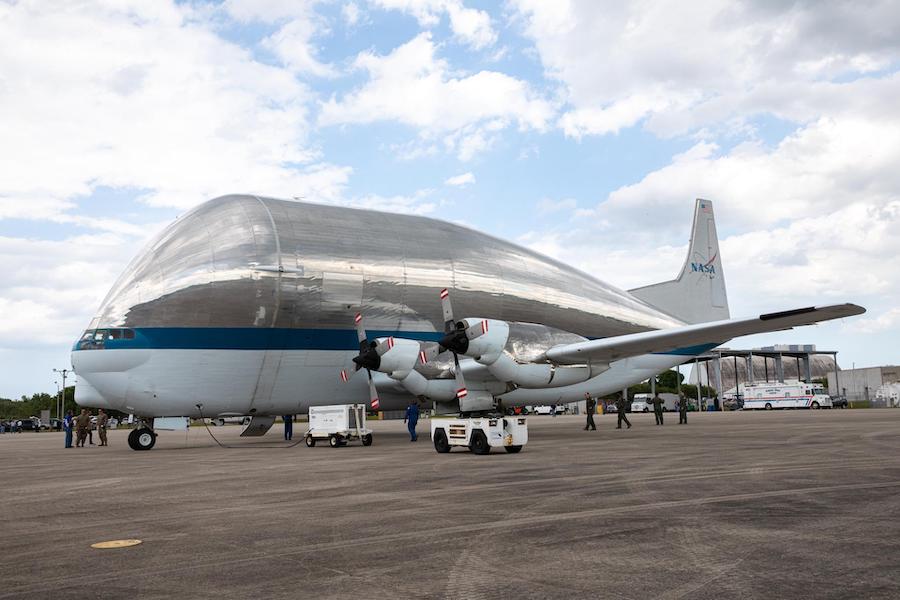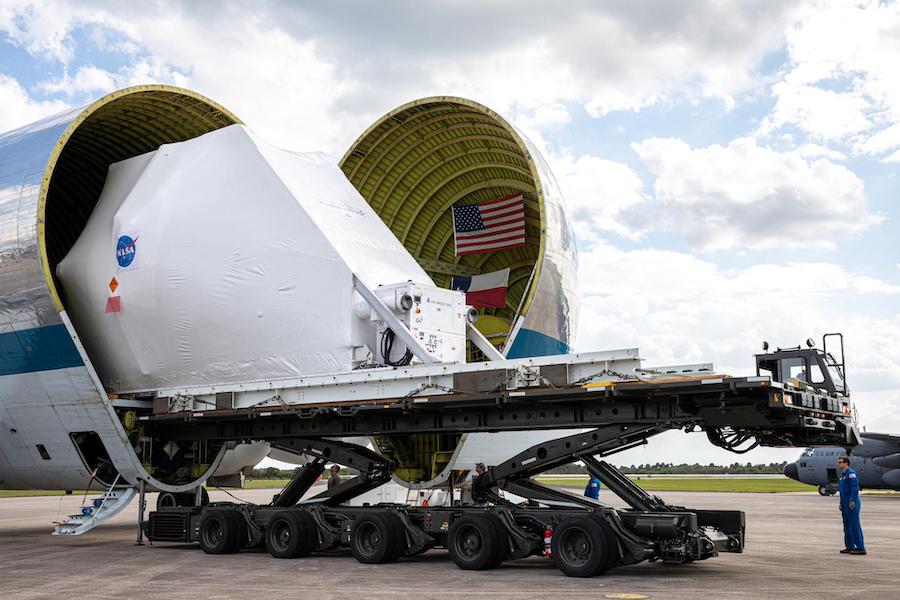Back in Florida, Orion capsule nears readiness for Artemis test flight – Spaceflight Now

The Orion spacecraft slated to fly around the moon on an unpiloted mission next year has arrived back at the Kennedy Space Center following an environmental test campaign in Ohio, ready for a series of final checkouts before officials pause launch preparations this summer to await readiness of NASA’s Space Launch System.
The spaceship is scheduled for launch next year on NASA’s Artemis 1 mission, a test flight of the SLS and Orion vehicles before astronauts are cleared to fly on the next SLS/Orion mission — Artemis 2 — around the moon in 2023.
The Trump administration has tasked NASA to return astronauts to the moon’s surface by the end of 2024 on the Artemis 3 mission. The Orion spacecraft is the vehicle that will take crews from Earth to the moon’s vicinity to rendezvous with a lunar lander, then return the astronauts home at the end of the mission.
The Orion crew capsule and its European service module for the Artemis 1 mission arrived at Kennedy’s Launch and Landing Facility — formerly the Shuttle Landing Facility — on March 25 aboard NASA’s propeller-driven Super Guppy transport plane. The Super Guppy returned the Orion spacecraft to the Florida launch base after four months at NASA’s Plum Brook Station in Sandusky, Ohio.
Teams unloaded the Orion spacecraft from the Super Guppy and transported it to the nearby Neil Armstrong Operations and Checkout Building, where Orion prime contractor Lockheed Martin assembles and readies Orion vehicles for flight.
Jules Schneider, Lockheed Martin’s assembly, test and launch operations manager at Kennedy, said ground crews planned to unpack the Orion spacecraft from its shipping container and rotate it from a horizontal to a vertical orientation, then install it on a test stand inside the O&C Building for inspections and functional testing to ensure the ship survived the trip from Ohio back to Florida.
The Orion spacecraft traveled from Kennedy to Plum Brook Station in November for testing inside a giant thermal vacuum chamber. During the testing, engineers subjected the spacecraft to the extremely cold and hot conditions the Orion spacecraft will see in deep space. Temperatures the Orion spacecraft experienced during the thermal vacuum test ranged from minus 250 to around 200 degrees Fahrenheit, according to NASA.
The engineers also pumped air out of the chamber to expose the entire Orion spacecraft — made up of a U.S.-built crew module and a European-made service module — to an airless vacuum simulating the deep space environment.
The team at Plum Brook also performed electromagnetic interference and compatibility tests, in which engineers verified all of the Orion spacecraft’s electronics work while operating simultaneously in the electromagnetic environment they will see in space, according to NASA.
The Orion spacecraft was powered up and performed well throughout the testing, officials said.
“The test went exceptionally well, especially considering we were doing all of this for the first time,” said Nicole Smith, testing project manager at NASA’s Glenn Research Center, which runs Plum Brook Station. “We found a lot of efficiencies throughout the thermal vacuum phase, and overcame a few facility equipment challenges early during electromagnetic interference testing, but our combined NASA, Lockheed Martin, ESA (European Space Agency) and Airbus team was able to complete the testing ahead of schedule.”
Lockheed Martin and other contractor teams completed assembly of the Orion spacecraft last year at Kennedy, months after the arrival of the ship’s European service module from an Airbus factory in Bremen, Germany.
The trip to Plum Brook was a final exam of sorts for the Orion spacecraft, stressing the entire vehicle to the hellish environment of spaceflight.

With the Orion spacecraft back in Florida, Schneider said Lockheed Martin crews will perform end-to-end subsystem testing, pressurize the vehicle’s propulsion system to check for leaks, and install four solar array wings on the ship’s service module. The fully deployed solar wings would not fit inside the test facility at Plum Brook, which houses the largest vacuum chamber in the world.
Technicians will also install fairings and covers over the base of the service module, along with the forward bay cover on the nose of the Orion crew module. Those steps will put the spacecraft into configuration for launch after the environmental testing in Ohio was performed with the Orion in the configuration will be in while flying in space.
Schneider said the Orion spacecraft will be ready to hand over to NASA in the June timeframe to begin steps to fuel the spacecraft and integrate the ship with its launch abort system.
Amanda Griffin, a NASA spokesperson at Kennedy, said teams plan to “continue mission processing” on the Orion spacecraft. That work is expected to continue unless Kennedy is elevated to Stage 4 of NASA’s coronavirus response framework, which would effectively close the center to nearly all employees.
Once technicians finish the end-to-end testing, propulsion leak checks, and the installation of Orion’s solar arrays and outer structure, officials plan to place the spacecraft in a “safe configuration” until it is turned over to NASA’s Exploration Ground Systems team to begin final launch preps, Griffin said.
The Orion spacecraft is expected to be ready to begin the Artemis 1 launch campaign before the Space Launch System.
NASA has suspended testing of the SLS core stage in at the Stennis Space Center in Mississippi due to concerns over the COVID-19 coronavirus pandemic. While some personnel at the Kennedy Space Center have been directed to telework, mission-essential employees continue working at the spaceport to keep the facility operational and prepare spacecraft for upcoming launches.
Stennis was elevated to Stage 4 of NASA’s coronavirus response framework earlier this month, while Kennedy remains at Stage 3 as of Monday.
The SLS core stage was being prepared for a fueling test and a test-firing of its four main engines this summer. That testing, already years behind schedule, is expected to slip further after the work stoppage at Stennis.
NASA plans to hold off on filling the Orion spacecraft’s propellant tanks for the Artemis 1 mission until the SLS is closer flight.

Once cleared to start the Artemis 1 launch campaign, the Orion spacecraft will be moved from the O&C Building to the nearby Multi-Payload Processing Facility. In that building, technicians will load hypergolic hydrazine and nitrogen tetroxide propellants to feed the Orion spacecraft’s thrusters, pump high-pressure gases into the vehicle, and fill the craft’s coolant loop with ammonia and Freon for the service module heat exchanger.
The next stop for Orion will be the Launch Abort System Facility, where personnel will install the spacecraft’s launch abort system, a needle-shaped tower with solid-fueled rockets that would ignite to pull the capsule away from an emergency during launch.
Then ground teams will transfer the Orion spacecraft to the Vehicle Assembly Building, where the ship will be lifted atop the Space Launch System heavy-lift rocket before rollout to pad 39B for launch.
Meanwhile, Lockheed Martin continues work on the Orion spacecraft for the Artemis 2 mission, the first flight to carry astronauts to the moon’s vicinity since 1972. The crew module’s primary and secondary structures are complete, and workers inside the O&C Building at Kennedy are currently welding propulsion system lines on the spacecraft, Schneider said.
That should be completed in a few months, followed by a proof test on the propulsion system welds. Then teams will begin adding electrical harnesses and outfitting the crew module with computers and other equipment.
The European service module for the Artemis 2 mission, which was to be delivered from Germany to Florida in June, is not expected to arrive in the United States until November, at the earliest, Schneider said, and that was before taking into account impacts from the COVID-19 pandemic.
Orion spacecraft for future missions will not travel to Plum Brook Station for environmental testing. Instead, the spacecraft will be assembled in Florida and go straight into processing for launch.
Email the author.
Follow Stephen Clark on Twitter: @StephenClark1.






